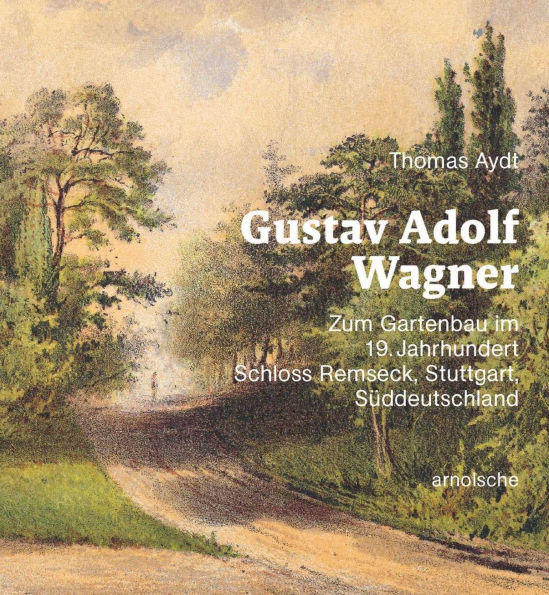Gustav Adolf Wagner: Zum Gartenbau im 19. Jahrhundert: Schloss Remseck - Stuttgart - Süddeutschland
In-depth exploration of Gustav Adolf Wagne's influential garden designs and their romantic aesthetics
• Highlights previously unpublished projects, enhancing understanding of 19th-century landscape design
• Showcases Wagne's significant impact on public green spaces for the growing middle class
This publication depicts the life and work of the Stuttgart garden designer Gustav Adolf Wagner (1817–1893), who in the second half of the 19th century adopted C.C.L. Hirschfeld’s and Ludwig Sckell’s new concepts of garden aesthetics and translated them into romantic park landscapes. His most significant works—which include the Stadtgarten in Stuttgart, the Faberpark near Nuremberg, and other public gardens in the City of Stuttgart such as Hasenberg, Karlshöhe, Feuersee, and Uhlandshöhe, which he supervised as the first garden inspector—are presented here in-depth for the very first time. Wagner’s gardens symbolize the need for public green spaces and urban park landscapes for an increasingly self-assured middle-class society. Numerous hitherto unpublished projects, for example from Wilhelm Neubert’s Schlüssel zur Bildenden Gartenkunst (1853) or from other contemporary sources, throw new light onto 19th-century garden landscape design and reintroduce the life and work of this unjustly forgotten garden designer. Text in German.
1146654049
• Highlights previously unpublished projects, enhancing understanding of 19th-century landscape design
• Showcases Wagne's significant impact on public green spaces for the growing middle class
This publication depicts the life and work of the Stuttgart garden designer Gustav Adolf Wagner (1817–1893), who in the second half of the 19th century adopted C.C.L. Hirschfeld’s and Ludwig Sckell’s new concepts of garden aesthetics and translated them into romantic park landscapes. His most significant works—which include the Stadtgarten in Stuttgart, the Faberpark near Nuremberg, and other public gardens in the City of Stuttgart such as Hasenberg, Karlshöhe, Feuersee, and Uhlandshöhe, which he supervised as the first garden inspector—are presented here in-depth for the very first time. Wagner’s gardens symbolize the need for public green spaces and urban park landscapes for an increasingly self-assured middle-class society. Numerous hitherto unpublished projects, for example from Wilhelm Neubert’s Schlüssel zur Bildenden Gartenkunst (1853) or from other contemporary sources, throw new light onto 19th-century garden landscape design and reintroduce the life and work of this unjustly forgotten garden designer. Text in German.
Gustav Adolf Wagner: Zum Gartenbau im 19. Jahrhundert: Schloss Remseck - Stuttgart - Süddeutschland
In-depth exploration of Gustav Adolf Wagne's influential garden designs and their romantic aesthetics
• Highlights previously unpublished projects, enhancing understanding of 19th-century landscape design
• Showcases Wagne's significant impact on public green spaces for the growing middle class
This publication depicts the life and work of the Stuttgart garden designer Gustav Adolf Wagner (1817–1893), who in the second half of the 19th century adopted C.C.L. Hirschfeld’s and Ludwig Sckell’s new concepts of garden aesthetics and translated them into romantic park landscapes. His most significant works—which include the Stadtgarten in Stuttgart, the Faberpark near Nuremberg, and other public gardens in the City of Stuttgart such as Hasenberg, Karlshöhe, Feuersee, and Uhlandshöhe, which he supervised as the first garden inspector—are presented here in-depth for the very first time. Wagner’s gardens symbolize the need for public green spaces and urban park landscapes for an increasingly self-assured middle-class society. Numerous hitherto unpublished projects, for example from Wilhelm Neubert’s Schlüssel zur Bildenden Gartenkunst (1853) or from other contemporary sources, throw new light onto 19th-century garden landscape design and reintroduce the life and work of this unjustly forgotten garden designer. Text in German.
• Highlights previously unpublished projects, enhancing understanding of 19th-century landscape design
• Showcases Wagne's significant impact on public green spaces for the growing middle class
This publication depicts the life and work of the Stuttgart garden designer Gustav Adolf Wagner (1817–1893), who in the second half of the 19th century adopted C.C.L. Hirschfeld’s and Ludwig Sckell’s new concepts of garden aesthetics and translated them into romantic park landscapes. His most significant works—which include the Stadtgarten in Stuttgart, the Faberpark near Nuremberg, and other public gardens in the City of Stuttgart such as Hasenberg, Karlshöhe, Feuersee, and Uhlandshöhe, which he supervised as the first garden inspector—are presented here in-depth for the very first time. Wagner’s gardens symbolize the need for public green spaces and urban park landscapes for an increasingly self-assured middle-class society. Numerous hitherto unpublished projects, for example from Wilhelm Neubert’s Schlüssel zur Bildenden Gartenkunst (1853) or from other contemporary sources, throw new light onto 19th-century garden landscape design and reintroduce the life and work of this unjustly forgotten garden designer. Text in German.
50.0
Pre Order
5
1

Gustav Adolf Wagner: Zum Gartenbau im 19. Jahrhundert: Schloss Remseck - Stuttgart - Süddeutschland
112
Gustav Adolf Wagner: Zum Gartenbau im 19. Jahrhundert: Schloss Remseck - Stuttgart - Süddeutschland
112Hardcover
$50.00
50.0
Pre Order

Product Details
| ISBN-13: | 9783897907386 |
|---|---|
| Publisher: | Arnoldsche Verlagsanstalt GMBH |
| Publication date: | 01/20/2026 |
| Pages: | 112 |
| Product dimensions: | 9.45(w) x 10.24(h) x (d) |
| Language: | German |
From the B&N Reads Blog
